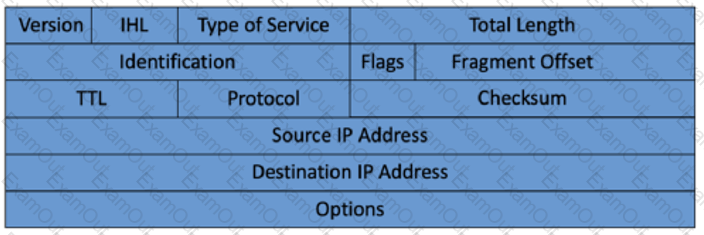The header in the exhibit belongs to the Internet Protocol version 4 (IPv4), which is the most widely used protocol for routing and delivering packets across networks. IPv4 is a connectionless and unreliable protocol that operates at the network layer of the OSI model. The IPv4 header consists of 20 bytes (160 bits) of fixed fields and up to 40 bytes (320 bits) of optional fields. The fixed fields include:
Version: 4 bits that indicate the version of the IP protocol, which is 4 for IPv4.
IHL (Internet Header Length): 4 bits that indicate the length of the IP header in 32-bit words, which is 5 for the minimum header size of 20 bytes.
Type of Service: 8 bits that indicate the quality of service (QoS) parameters for the packet, such as precedence, delay, throughput, and reliability.
Total Length: 16 bits that indicate the total length of the IP packet in bytes, including the header and the data.The maximum value is 65535 bytes.
Identification: 16 bits that identify the packet for fragmentation and reassembly purposes.
Flags: 3 bits that control the fragmentation of the packet. The first bit is reserved and must be zero. The second bit is the Don’t Fragment (DF) bit, which indicates whether the packet can be fragmented or not. The third bit is the More Fragments (MF) bit, which indicates whether the packet is the last fragment or not.
Fragment Offset: 13 bits that indicate the position of the fragment in the original packet, measured in units of 8 bytes.
TTL (Time To Live): 8 bits that indicate the maximum number of hops that the packet can traverse before being discarded. The TTL is decremented by one at each hop, and the packet is dropped if the TTL reaches zero.
Protocol: 8 bits that indicate the protocol of the data carried in the packet, such as TCP, UDP, ICMP, etc. The protocol numbers are defined in the List of IP protocol numbers.
Header Checksum: 16 bits that provide error detection for the IP header. The checksum is calculated by adding the 16-bit words of the header and taking the one’s complement of the result.The checksum is recomputed and verified at each hop.
Source IP Address: 32 bits that indicate the IP address of the sender of the packet.
Destination IP Address: 32 bits that indicate the IP address of the receiver of the packet.
Options: Variable-length field that contains optional information for the IP packet, such as security, routing, timestamp, etc. The options are padded with zeros to make the header length a multiple of 32 bits.
The IPv4 header can be distinguished from other protocol headers by the value of the Version field, which is 4 for IPv4. Other protocol headers have different values for the Version field or do not have a Version field at all. For example, the IPv6 header has a Version field of 6, the UDP header does not have a Version field, the Ethernet header has a Type field instead of a Version field, and the TCP header has a Data Offset field instead of a Version field. References:



